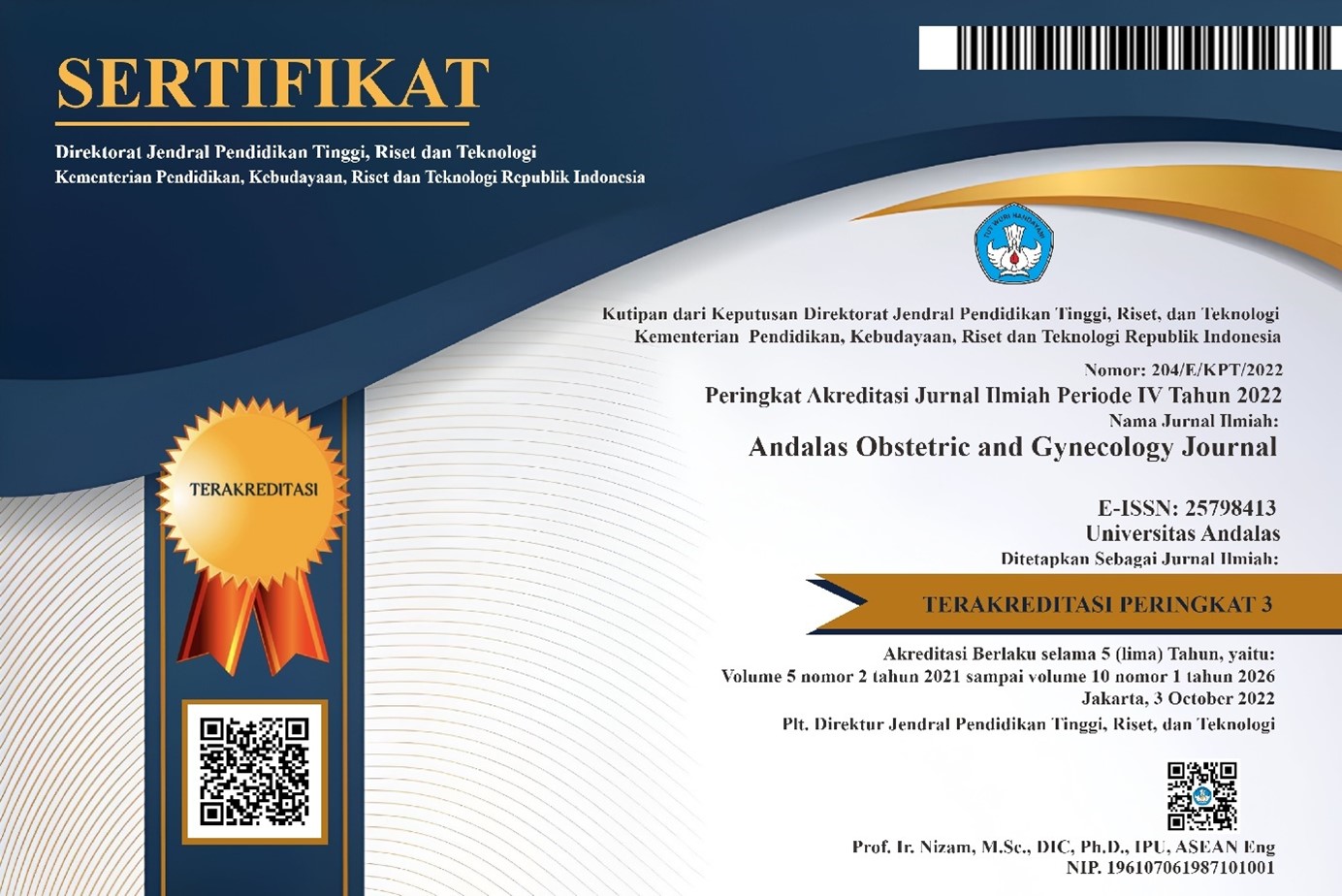The Relationship Between the Stress Level and the Vaginitis Symptomps Toward Batch 2019 Students of Faculty of Medicine Andalas University
DOI:
https://doi.org/10.25077/aoj.4.1.62-69.2020Abstract
Objective: determine the relationship between stress levels with symptoms of vaginitis in medical students at the Faculty of Medicine, Andalas University batch 2019.
Method: was observational analytic with cross-sectional approach. Sampling was conducted by non-probability sampling. The sample was 140 by conducting a guided interview on 140 female students of the Medical Education Faculty of Andalas University batch 2019. The stress level of the female students was measured by a stress questionnaire from the Depression Anxiety Stress Scale (DASS 42) and vaginitis symptoms questionnaire. Data analysis used Chi-Square test.
Result: more than half of respondents which is 71 respondents (50,6%) has stress. Then, moderate stress levels is the largest percentage, that is 31 respondents (43,6%). Most respondents, 121 respondents (86.4%) have experienced symptoms of vaginitis. The statistical test results obtained p-value = 0.943.
Conclusion: more than half of repondents has stress and most respondents have experienced symptoms of vaginitis. The p-value showed that there is no significant relationship between stress levels and symptoms of vaginitis.
Keywords: Stress, vaginitis, adolescentReferences
Batubara J. Adolescent development. Sari Pediatri. 2010;12(1):21-9.
Kementerian Kesehatan RI. INFODATIN Pusat Data dan Informasi Kemeterian Kesehatan RI Situasi Kesehatan Remaja. 2015:2-7.
International Institute for Population Sciences. National Family Health Survey (NFHS-3).India: The institute;2007:I:224-33.
Bitew A, Abebaw Y, Bekele D, Mihret A. Prevalence of bacterial vaginosis and associated risk factors among women complaining of genital tract infection. International Journal of Microbiology.2017:1-6.
Hainer BL, Gibson MV. Vaginitis: Diagnosis and treatment. Am Fam Physician. 2011;83(7):807–15.
Rustiana E, Cahyati W. Stress kerja dengan pemilihan strategi coping. Jurnal Kesehatan Masyarakat. 2012:7(1):149-55.
Wahed WYA, Hassan SK. Prevalence and associated factor of stres, anxiety and depression among medical Fayom University students. Alexandria Journal of medicine. 2017; 53(1): 77-84.
Rahmayani R, Liza R, Syah N. Gambaran tingkat stress berdasarkan stressor pada mahasiswa kedokteran tahun pertama program studi profesi dokter fakultas kedokteran Universitas Andalas angakatan 2017. Jurnal Kesehatan Andalas.2019;8(1):103-8.
Turovskiy Y, Noll K, Chikindas M. The etiology of bacterial vaginosis. J Appl Microbiol.2011.110(5): 1105–28.
Cauci S. Vaginal Immunity in Bacterial Vaginosis.Curr Infect Dis Rep.2004;6(6): 450-6.
Dahlan SM. Besar Sampel dan Cara Pengambilan Sampel. Jakarta: Salemba Medika; 2013.
Isnayanti D, Harahap N. Stress levels and stressors of first year students in faculty of medicine,University of Muhammmadiyah Sumatera Utara. 2018;194–8.
Augesti G, Lisiswanti R, Saputra O,Nisa K. Differences in stress level between first year and last year medical students in medical faculty of Lampung University.J majority.2015;4(4):50-6.
Marjani A, Gharavi AM, Jahanshahi M, Vahidirad A, Alizadeh F. Stress among medical students of Gorgan (South East of Caspian Sea) Iran. Kathmandu University Medical Journal. 2008;6(3): 421-5.
Saerang A, Suparman E, Lengkong RA. Hubungan antara stres dengan menstruasi pada mahasiswi Fakultas Kedokteran Universitas Sam Ratulangi Manado angkatan 2010. Jurnal E-clinic:2014;2(3).
Hawari D. Manajemen Stress, Cemas dan Depresi. 2nd ed. Balai Penerbit FK UI; 2009.
Wade C, Tavris C. Psikologi Jilid II. Jakarta: Erlangga.2007:423-4.
Goliszek A. Manajemen stress : Cara tercepat Untuk Menghilangkan Rasa Cemas. In Jakarta: Bhuana Ilmu Populer; 2005.
Gialini WU. Hubungan vaginal hygiene dengan kejadian vaginitis pada siswi SMA Muhammadiyah 1 Palembang.2019.
Aubyn GB, Tagoe DNA. Prevalence of vaginal infections and associated lifestyles of students in the University of Cape Coast,Ghana.2013;3(4):267-70.
Singh N, Singh J. Study of risk factors for infectious vaginitis in reproductive women. 2018;5(12):7-9.
Pratiwi TM, Sabilu Y, Fachlevy F. Hubungan pengetahuan, stres, penggunaan antiseptic dan penggunaan pembalut dengan kejadian fluor albous pada remaja siswi SMA Negeri 8 Kendari tahun 2017. 2017;2(6):1-8.
Cohrssen A, Aslam U, Karasz A, Anderson MA. Are unexplained vaginal symptoms associated with psychosocial distress? A pilot investigation.2010;2(2):150-4.
Kokotos F. Vulvovaginitis. Pediatrics in review.2006;27(3):116-7.
Sikanic ND. Nives P.Vlasta HH. Amarela LG. Microbiological findings in prepubertal girls with vulvovaginitis. Acta Dermatovenerol Croat. 2009;17(4):26
Downloads
Published
Issue
Section
License
Copyright (c) 2020 Andalas Obstetrics And Gynecology Journal

This work is licensed under a Creative Commons Attribution 4.0 International License.
Copyright
Authors who publish with this journal agree to the following terms:
- Authors retain the copyright of published articles and grant the journal right of first publication with the work simultaneously licensed under a Creative Commons Attribution 4.0 International License that allows others to share the work with an acknowledgment of the work's authorship and initial publication in this journal.
- Authors are able to enter into separate, additional contractual arrangements for the non-exclusive distribution of the journal's published version of the work (e.g., post it to an institutional repository or publish it in a book), with an acknowledgment of its initial publication in this journal.
- Authors are permitted and encouraged to post their work online (e.g., in institutional repositories or on their website) prior to and during the submission process, as it can lead to productive exchanges, as well as earlier and greater citation of published work (See The Effect of Open Access).
License:
Andalas Obstetrics and Gynecology Journal (AOJ) is published under the terms of the Creative Commons Attribution 4.0 International License. This license permits anyone to copy and redistribute this material in any form or format, compose, modify, and make derivatives of this material for any purpose, including commercial purposes, as long as they credit the author for the original work.







